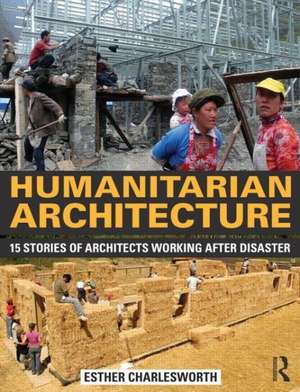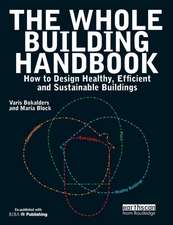Humanitarian Architecture: 15 stories of architects working after disaster
Autor Esther Charlesworthen Limba Engleză Paperback – 26 iun 2014
This book documents and analyses the expanding role for architects in designing projects for communities after the event of a natural disaster. The fifteen case studies featured in the body of the book illustrate how architects can use spatial sensibility and integrated problem-solving skills to help alleviate both human and natural disasters. The cases include:
- Lizzie Babister - Department of International Development, UK.
- Shigeru Ban - Winner of The Pritzker Architecture Prize 2014, Shigeru Ban Architects and Voluntary Architects’ Network, Japan.
- Eric Cesal – Disaster Reconstruction and Resiliency Studio and Architecture for Humanity, Japan.
- Hsieh Ying Chun – Atelier 3, Taiwan.
- Nathaniel Corum - Education Outreach and Architecture for Humanity, USA.
- Sandra D’Urzo - Shelter and Settlements and International Federation of the Red Cross and Red Crescent Societies, Switzerland.
- Brett Moore - World Vision International, Australia.
- Michael Murphy - MASS Design Group, USA.
- David Perkes - Gulf Coast Community Design Studio, USA.
- Paul Pholeros - Healthabitat, Australia.
- Patama Roonrakwit - Community Architects for Shelter and Environment, Thailand.
- Graham Saunders - International Federation of Red Cross and Red Crescent Societies, Switzerland.
- Kirtee Shah - Ahmedabad Study Action Group, India.
- Maggie Stephenson - UN-HABITAT, Haiti.
- Anna Wachtmeister - Catholic Organisation for Relief and Redevelopment Aid, the Netherlands.
| Toate formatele și edițiile | Preț | Express |
|---|---|---|
| Paperback (1) | 252.81 lei 6-8 săpt. | |
| Taylor & Francis – 26 iun 2014 | 252.81 lei 6-8 săpt. | |
| Hardback (1) | 1046.09 lei 6-8 săpt. | |
| Taylor & Francis – 25 iun 2014 | 1046.09 lei 6-8 săpt. |
Preț: 252.81 lei
Preț vechi: 299.16 lei
-15% Nou
Puncte Express: 379
Preț estimativ în valută:
48.38€ • 50.61$ • 40.19£
48.38€ • 50.61$ • 40.19£
Carte tipărită la comandă
Livrare economică 02-16 aprilie
Preluare comenzi: 021 569.72.76
Specificații
ISBN-13: 9780415818674
ISBN-10: 0415818672
Pagini: 264
Ilustrații: 137 colour illustrations
Dimensiuni: 189 x 246 x 18 mm
Greutate: 0.72 kg
Ediția:New.
Editura: Taylor & Francis
Colecția Routledge
Locul publicării:Oxford, United Kingdom
ISBN-10: 0415818672
Pagini: 264
Ilustrații: 137 colour illustrations
Dimensiuni: 189 x 246 x 18 mm
Greutate: 0.72 kg
Ediția:New.
Editura: Taylor & Francis
Colecția Routledge
Locul publicării:Oxford, United Kingdom
Public țintă
Postgraduate, Professional, Professional Practice & Development, and UndergraduateCuprins
Acknowledgements Foreword: Human Architecture – Michael Sorkin Introduction: A World of Disasters: The Rise and Rise of Humanitarian Architecture – Esther Charlesworth Part 1: Private Architecture Practice Based Humanitarian Architects 1. Voluntary Architect’s Network, Japan - Shigeru Ban 2. Atelier 3, Taiwan - Hsieh Ying-Chun 3. Mass Design Group, USA - Michael Murphy 4. Healthabitat, Australia - Paul Pholeros 5. Community Architects for Shelter and Environment (CASE), Thailand - Patama Roonrakwit Part 2: University-Research Based Humanitarian Architects 6. Architecture for Humanity, USA - Nathaniel Corum 7. Gulf Coast Community Design Studio, USA - David Perkes Part 3: NGO/International Aid Based Humanitarian Architects 8. Department of International Development, UK - Lizzie Babister 9. Architecture for Humanity, Japan - Eric Cesal 10. International Federation of the Red Cross and Red Crescent Societies (IFRC), Switzerland - Sandra D’Urzo 11. World Vision International, Australia - Brett Moore 12. International Federation of the Red Cross and Red Crescent Societies, Switzerland - Graham Saunders 13. Ahmedabad Study Action Group (ASAG), India - Kirtee Shah 14. UN-HABITAT, Haiti - Maggie Stephenson 15. Cordaid, The Netherlands - Anna Wachtmeister Part 4: Future Roles for the Humanitarian Architect Epilogue 1: Putting the public in design – Bryan Bell Epilogue 2: Architecture as service – Ian Davis Epilogue 3: Sending out an SOS – Rory Hyde Glossary Index.
Notă biografică
Esther Charlesworth is the Founding Director of Architects without Frontiers (Australia), a design non-profit organization committed to working with communities in need. She is Associate Professor in Architecture and Design at RMIT University, Melbourne, Australia.
Recenzii
'What is humanitarian architecture? What is the role of architects and designers in the field of humanitarian action? This collection of personal stories and practical experiences provides a much needed insight into the business of post-disaster shelter, from individuals whose diverse work with communities affected by natural and man-made crises has done much to shape the understanding of and approach to shelter after disaster.' - Graham Saunders, Head, Shelter & Settlements, International Federation of Red Cross and Red Crescent Societies
'Challenging the conventional "wisdom" about the role of architecture and architects in reconstruction, Esther Charlesworth assembles seminal views from a wide range of experienced professionals looking up and out from the wreckage of cities destroyed by various calamity, to thoughtful insights of academics on design vs. construct, and reflections on innovations past and future. A must-have reference in the libraries of professionals engaged in supporting the recovery and reconstruction of towns and cities struck by war, disaster, or decay.' - Dan Lewis, Chief, Urban Risk Reduction, UN-Habitat
'A ground-breaking book that is essential reading for students, designers and recovery officials. Containing rich experiences by leaders in the field and highly creative designers, this will inspire, inform and guide readers to become involved in a noble humanitarian cause.' - Ian Davis, author of Shelter after Disaster (1978), visiting Professor in Disaster Risk Management in Copenhagen, Lund, Kyoto and Oxford Brookes Universities
'Why aren’t we better prepared for these frequent disasters that devastate communities? We can and should do better. We have an obligation to humanity to make progress each time. These fifteen cases in Humanitarian Architecture: 15 stories of architects working after disaster are a good way to learn from what experts have done and how we can all move forward from here.' - Bryan Bell, Founder and Executive Director of Design Corps
'Challenging the conventional "wisdom" about the role of architecture and architects in reconstruction, Esther Charlesworth assembles seminal views from a wide range of experienced professionals looking up and out from the wreckage of cities destroyed by various calamity, to thoughtful insights of academics on design vs. construct, and reflections on innovations past and future. A must-have reference in the libraries of professionals engaged in supporting the recovery and reconstruction of towns and cities struck by war, disaster, or decay.' - Dan Lewis, Chief, Urban Risk Reduction, UN-Habitat
'A ground-breaking book that is essential reading for students, designers and recovery officials. Containing rich experiences by leaders in the field and highly creative designers, this will inspire, inform and guide readers to become involved in a noble humanitarian cause.' - Ian Davis, author of Shelter after Disaster (1978), visiting Professor in Disaster Risk Management in Copenhagen, Lund, Kyoto and Oxford Brookes Universities
'Why aren’t we better prepared for these frequent disasters that devastate communities? We can and should do better. We have an obligation to humanity to make progress each time. These fifteen cases in Humanitarian Architecture: 15 stories of architects working after disaster are a good way to learn from what experts have done and how we can all move forward from here.' - Bryan Bell, Founder and Executive Director of Design Corps
Descriere
This book documents and analyses the expanding role for architects in designing projects for communities after the event of a natural disaster. The fifteen case studies featured in the body of the book illustrate how architects can use spatial sensibility and integrated problem-solving skills to help alleviate both human and natural disasters.













